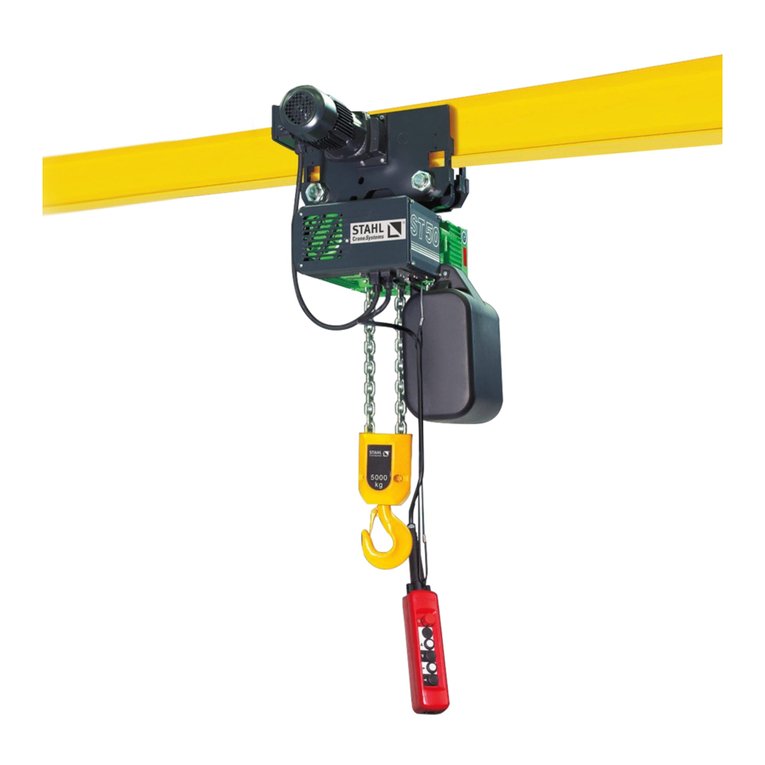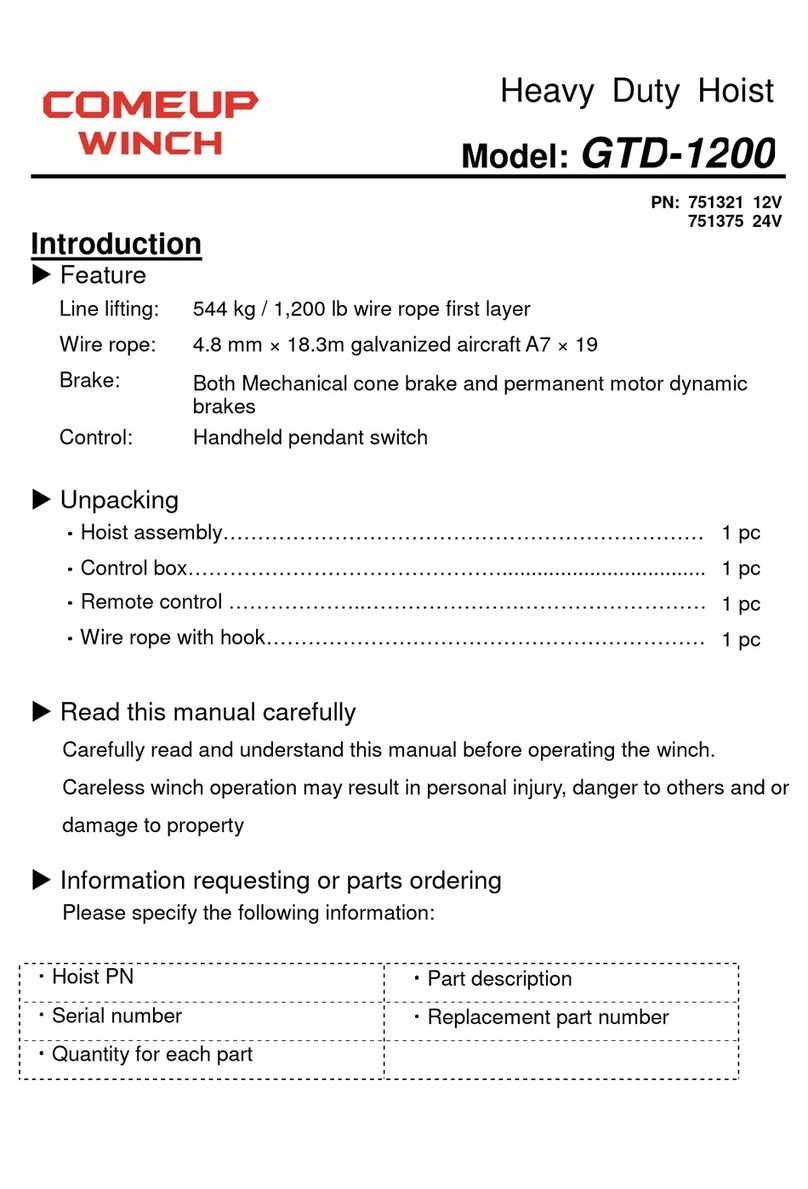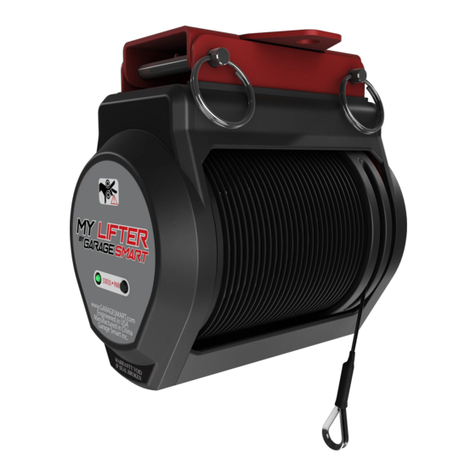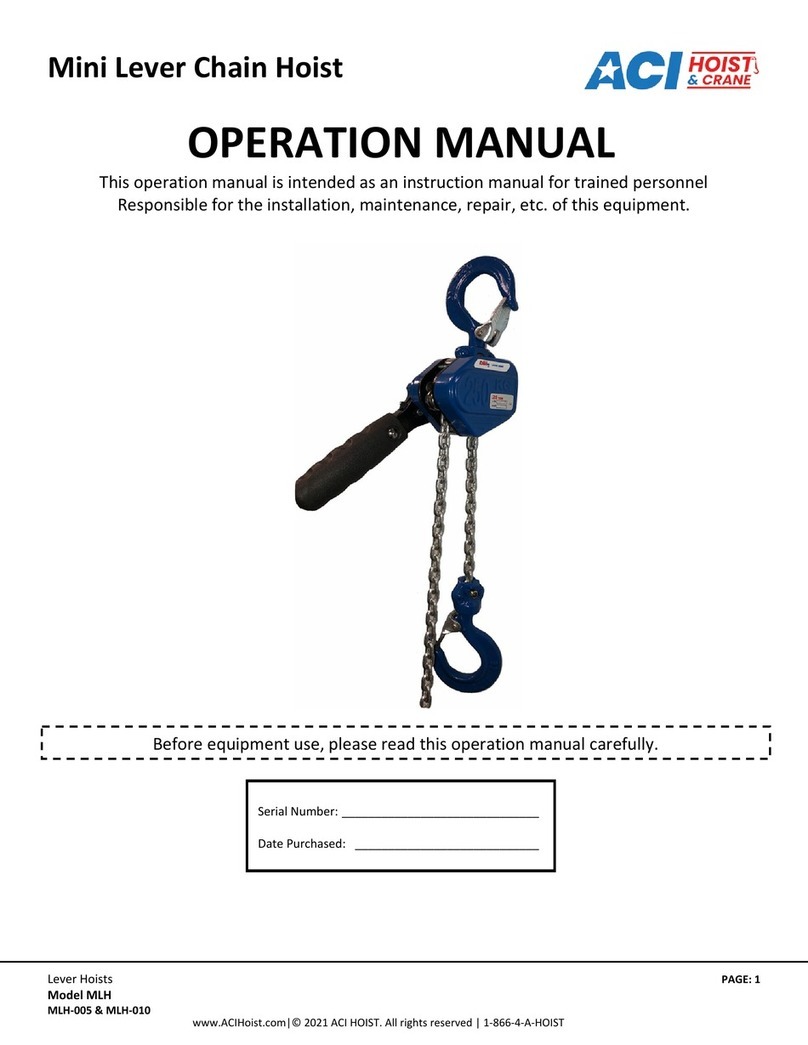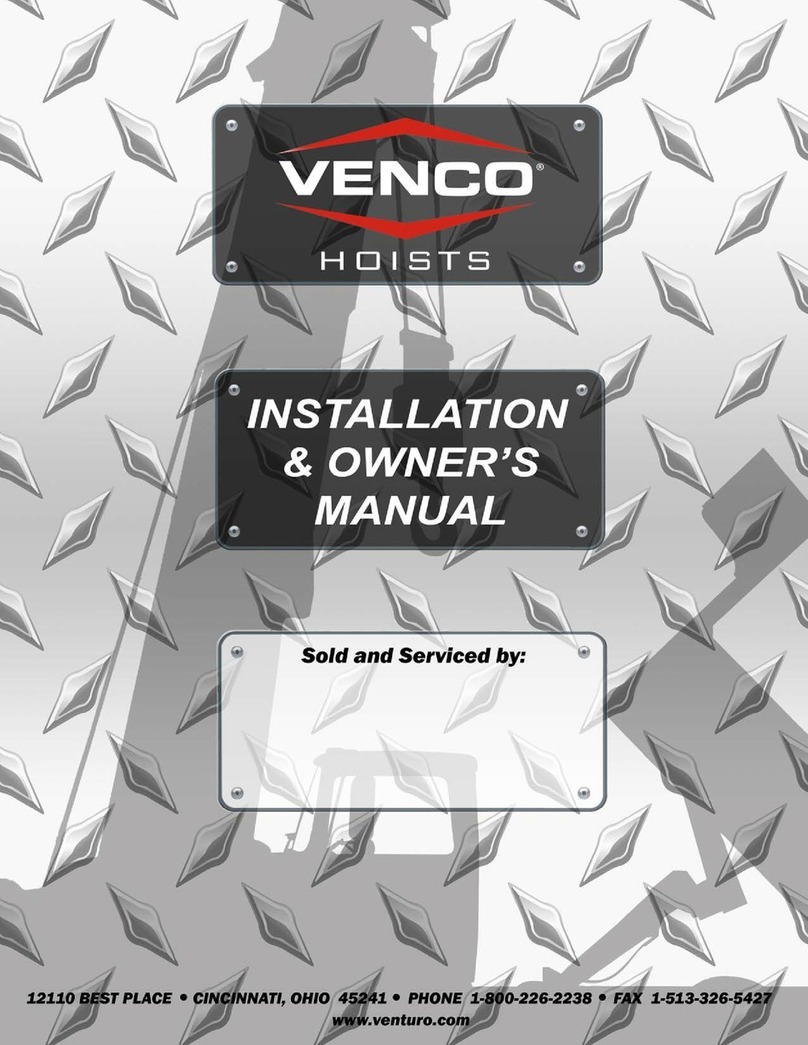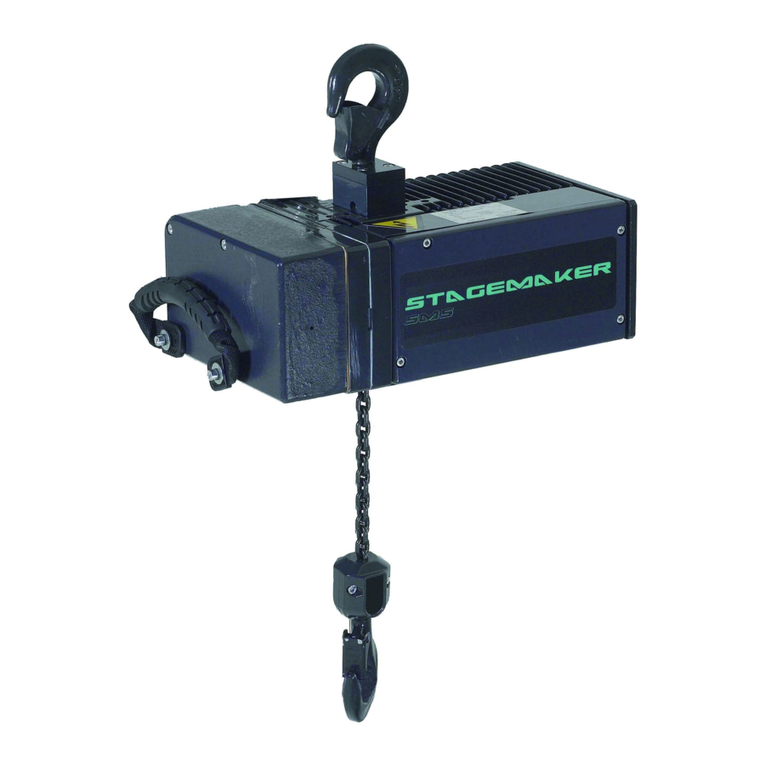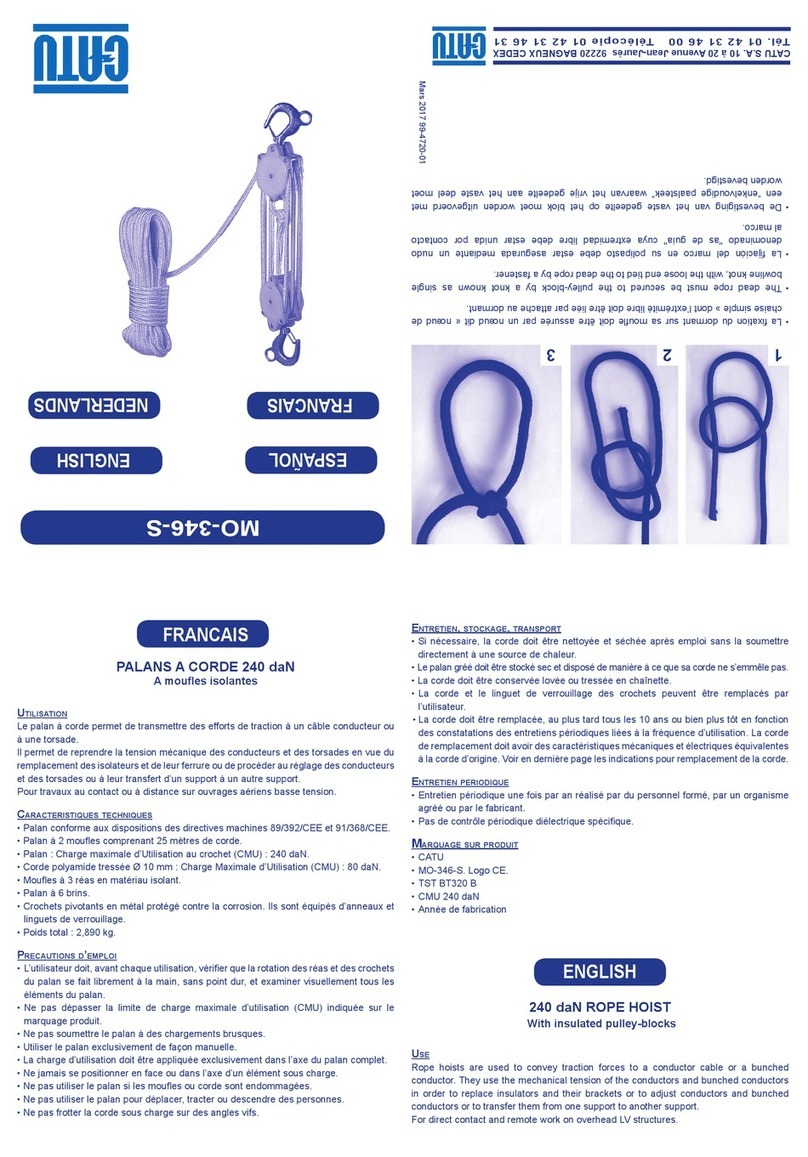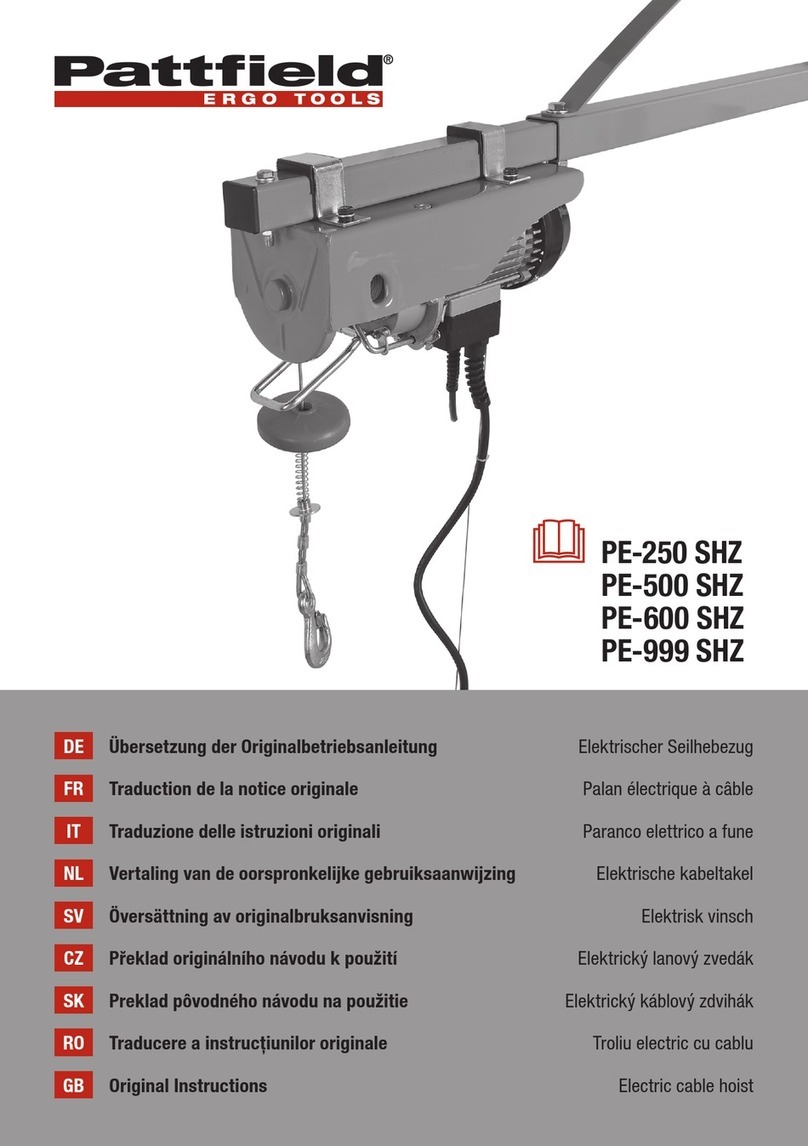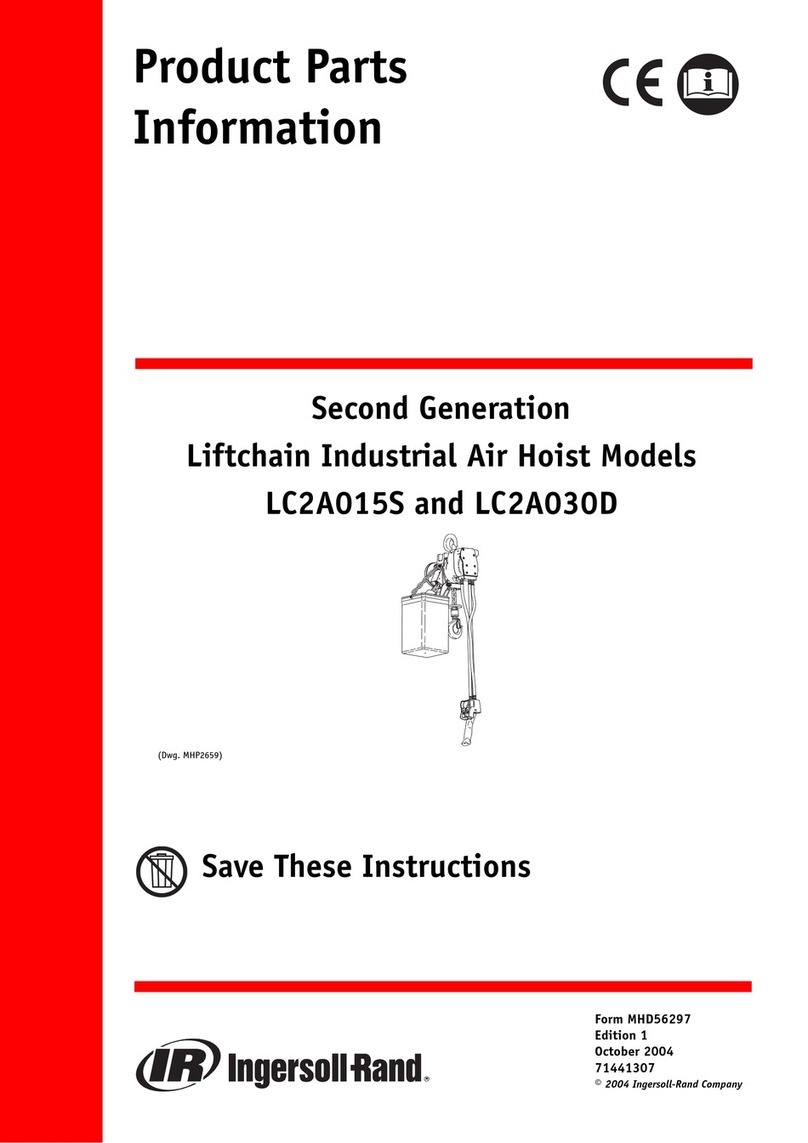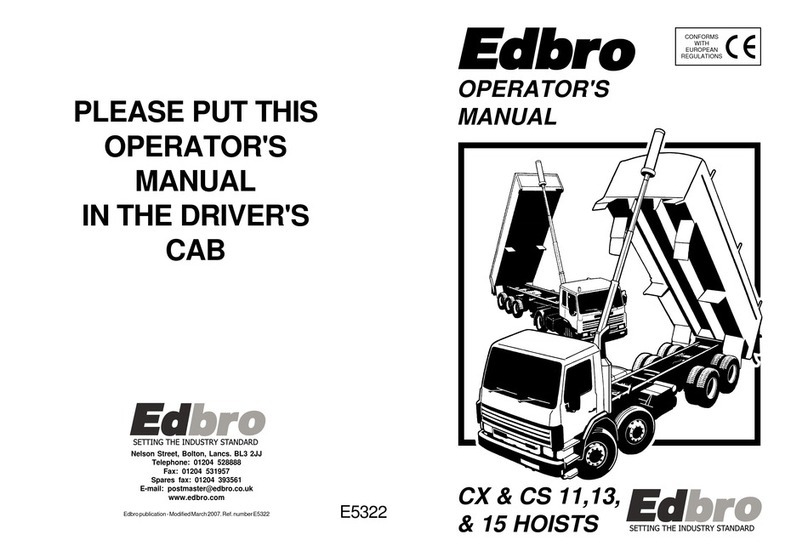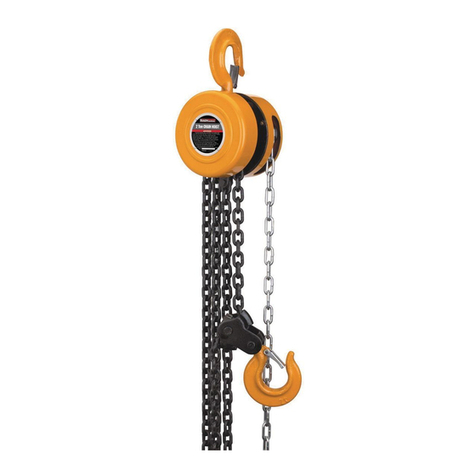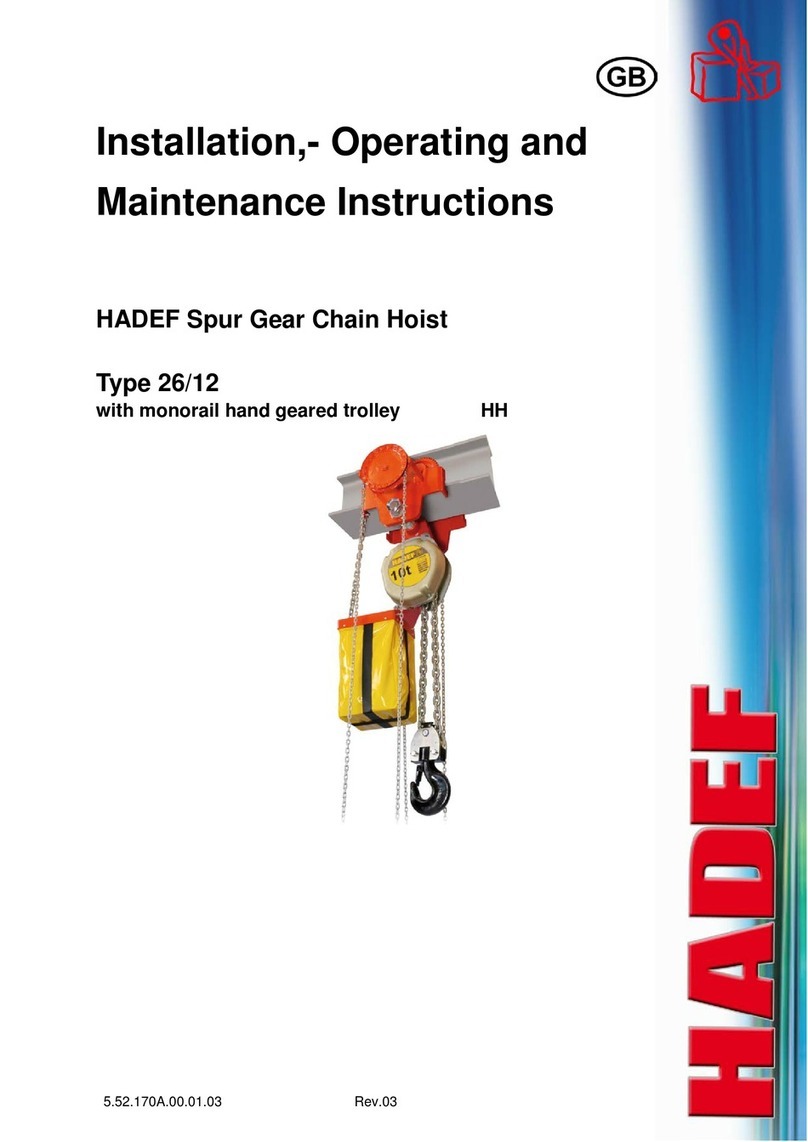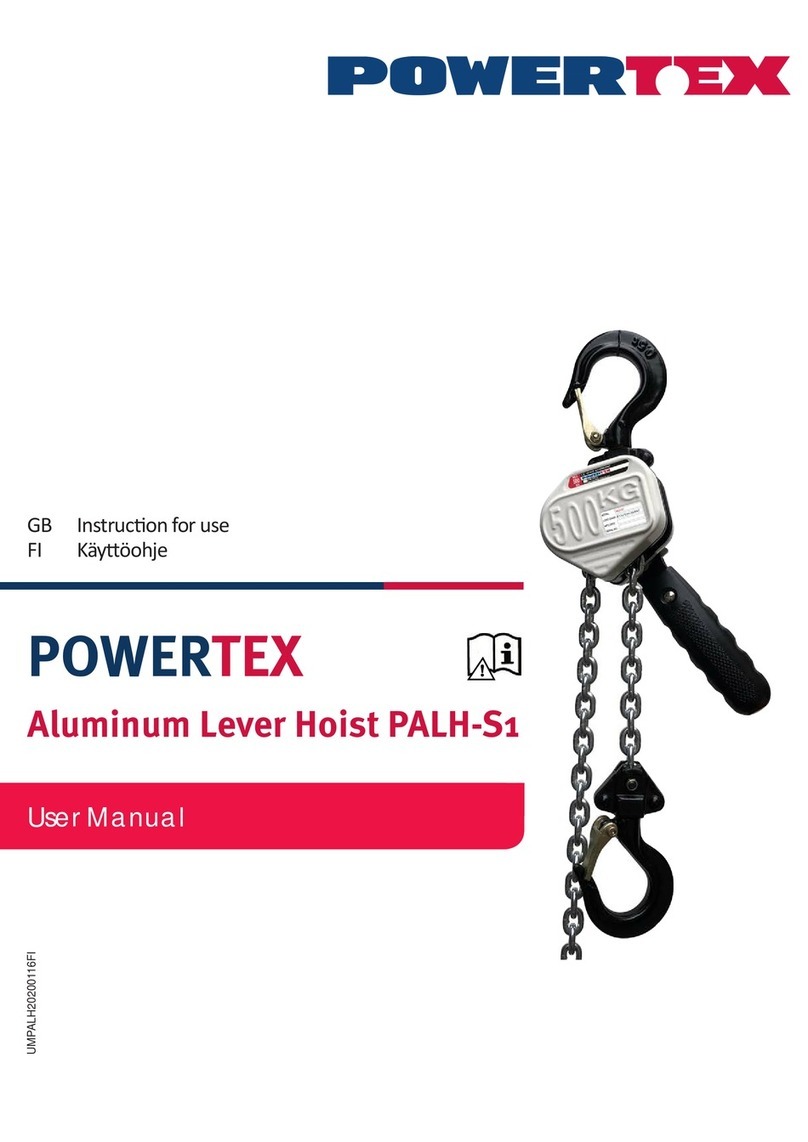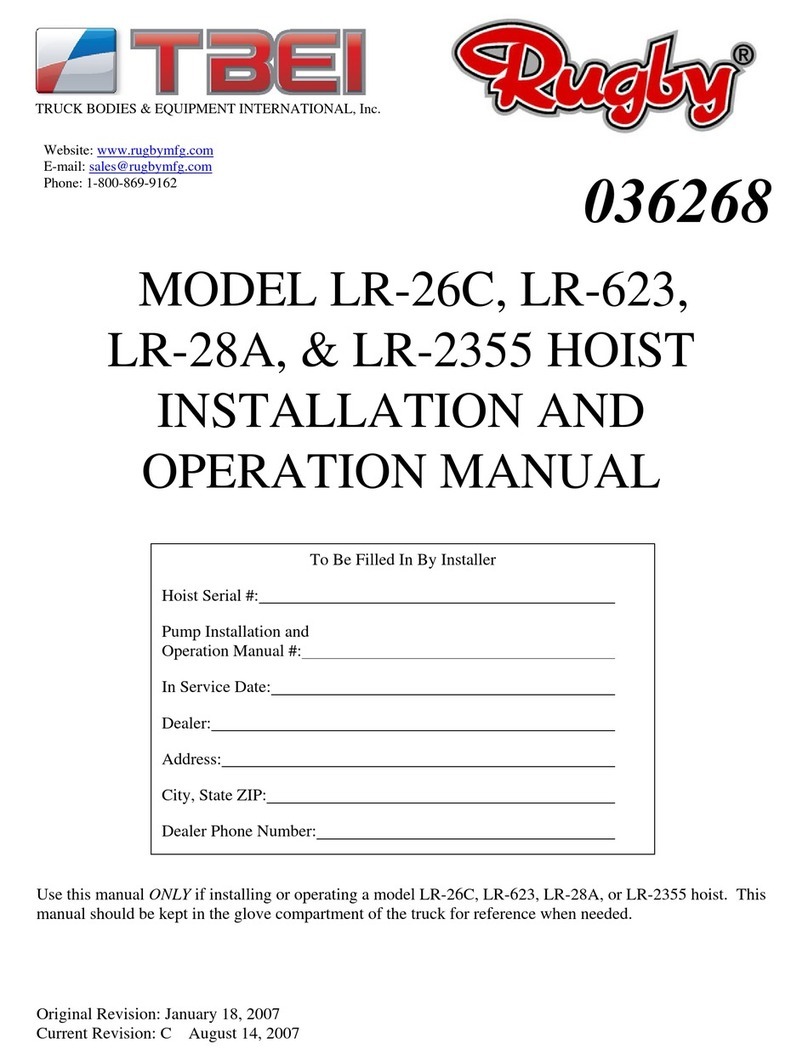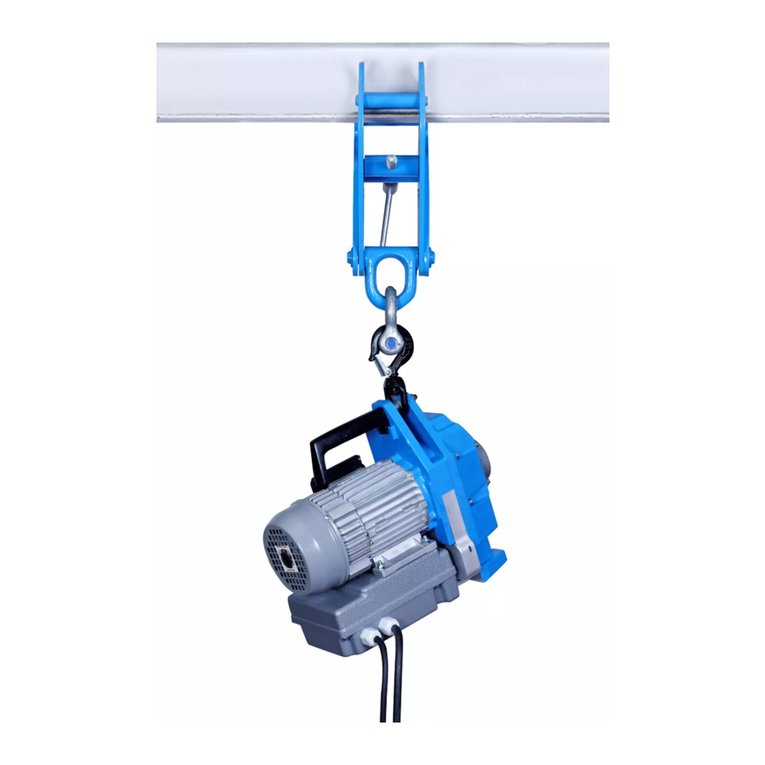
1. GENERAL INFORMATION
Attention: All users must read these operating
instructions carefully prior to the initial operation. These
instructions are intended to acquaint the user with the
hoist controller and enable him/her to use it to the full
extent of its intended capabilities.
The operating instructions contain important information
on how to handle the hoist controller in a safe, correct and
economic way. Acting in accordance with these
instructions helps to avoid dangers, reduce repair costs
and downtime and to increase the reliability and lifetime of
the hoist controller.
Anyone involved in doing any of the following work with
the hoist controller must read the operating instructions
and act accordingly:
•Operation, including preparation, trouble shooting and
cleaning
•Maintenance, inspection, repair
•Transport
Apart from the operating instructions and the accident
prevention act valid for the respective country and area
where the hoist controller is used, also the commonly
accepted regulations for safe and professional work must
be adhered to.
The user is responsible for the proper and professional
instruction of the operating personnel.
Suitable for entertainment use
The PROLYFT AETOS hoist controllers are specially
designed for use in the Entertainment industry. They must
only control electric chain hoists that are suitable for use
in the Entertainment industry.
Combining the hoist controller with different type of
electric chain hoists might lead to unwanted, unexpected
or dangerous situations.
The PROLYFT AETOS hoist controllers are not designed
to control hoists suspending or lifting loads above people.
Read the manual of the electric chain hoists before
starting to operate them with the hoist controller.
Regulations
The accident prevention act and/or safety regulations of
the respective country for using manual and electric chain
hoists must be strictly adhered:
•Europe:
•Machine Directive 2006/42/EG
•Safety of Machinery NEN 12100:2010
•Germany: BGV D6, BGV D8
Additional regulations are in effect for lifting or suspending
loads over people.
Germany: SQ P2
The Netherlands: NPR8020-10
United Kingdom: BS7950-1
Maintenance/Repair
In order to ensure correct operation, not only the
operating instructions, but also the conditions for
inspection and maintenance must be complied with. If
defects are found or abnormal noise is to be heard stop
using the hoist controller immediately.
Attention: Before starting to work on electrical
components the power-supply is to be cut off.
2. INCORRECT OPERATION
•Do not exceed the rated power capacity per controlled
channel.
•Do not lift stuck or jammed loads.
•Do not shortly and frequently actuate the up/down
switch.
•Do not control hoists if the movement of the load is not
visible from the operating position.
•Do not control hoists if you are skilled for lifting loads
•Do not use cables with damaged strain reliefs and/or
isolation.
•Do not use any input- or output cables that are not
suitable for the supplied voltage and / or current.
•Do not use the Thuja data connection (link in, link out)
with other network devices unless these devices are
specified to be suitable for use in the Thuja data
network.
•Do not connect the controller to a mains connection that
is not properly fused.
•Do not use the controller without proper grounding.
•Do not connect more then one hoist on a single
channel.
3. ELECTRIC CONNECTIONS
All electric connections must be used with respect for the
specified voltages and maximum power consumption.
Power input:
The power input connector is a 5pin CEEform connector
suitable for 3 phase 32Amp / 400Volt. 3 Phases, neutral
and ground.
Depending on the type of controller it can be plugged in to
either a 3 phase 400V or a 3 phase 230V mains
connections.
Make sure the mains connection is fused at maximum
32Amps per phase. It is advised to use circuit breakers
with a C or D characteristic.
Make sure the mains connection is properly grounded.
Improper grousing might lead to dangerous with the risk
of electric shock.
Maximum power consumption per hoist.
Each hoist channel is capable of switching an electric
chain hoist with maximum power consumption of 1,5kW.
Power output to the hoists
For each 4 hoist channels there is a Harting 16 output
connector.
Make sure the cables (and each individual wire of the
cable) connected to the output connector are suitable for
minimum 10Amps at 400V per wire.
To avoid voltage drops longer cables should have bigger
wire diameters.
AETOS Range
11
Inspection of chain end stop
The chain end stop must be connected to the dead (idle) end of the chain
strand.
Inspection of chain reeving
All units with two or more chain strands should be inspected prior to initial
operation for twisted or kinked chains. The chains of 2-strand hoists may be
twisted if the hook block was rolled over (Fig. 13).
The load chain has to be installed according to illustration (Fig. 15). Hereby the
welds on the standing links must face away from the load sheave.
Inspecting the hooks
Check the load hook and the suspension hook for deformations, cracks,
damages, abrasion and signs of corrosion.
Attaching the load
Attach the load to the hoist using only approved and certified slings or lashing
devices. Never use the load chain as sling chain. The load must always be
seated in the saddle of the hook (Fig. 14). Never attach the load to the tip of
the hook. Two parts of a bridles of slings or steels must not exceed an angle of
45 degrees. Use a shackle to attach the bridle. Do not remove the safety latch
from the load hook. Always check the attachment of the load after the load has
“landed”.
Lifting/lowering the load
• Never lift a load without direct visual contact with the load.
• The load is lifted by depressing the UP-button, it is lowered by
depressing the DOWN-button.
• For hoists with two speeds: The first stage of button depression
activates the slow speed, further depression activates the faster speed. In
order to raise the load, always use the lowest available lifting speed. The
chain must be loaded at this speed and should not lie slack on the floor.
The slow speed should only be used for short distances.
• The chain end stop may not be used as operational limit switch.
• Always follow the instructions in the manual of the operating/control
device.
Emergency stop
All movement can be immediately halted by depressing the red, mushroom
shaped button on the pendant control.
Attention: Operating the red emergency button does NOT ALWAYS
automatically disconnect the mains supply to the hoist. To release the
emergency stop, rotate the button in a clockwise direction.
End limit switch
This hoist is provided with an end limit switch for the lowest and highest hook
position as standard. This limit switch is a safety device and may not be used
as operational limiting device.
7.OPERATION / USE
Operator skills
Operators delegated to install, service or independently operate the hoist must
have had suitable training and be competent.
Operators are to be specifically nominated by the company and must be
familiar with all relevant safety regulations of the country of use.
Visual inspection before starting work
Before starting work inspect the hoist, chains and all load bearing components
every time for visual defects. Furthermore test the brake and make sure that
the load and hoist are correctly attached by carrying out a short work cycle of
lifting and lowering. Selection and calculation of the proper suspension point
and beam construction are the responsibility of the operating company.
Inspection of load chain
Inspect the chain for sufficient lubrication and visually check for external
defects, deformations, superficial cracks, wear or signs of corrosion.
5. FUNCTIONAL CHECK BEFORE EVERY INSTALL
Prior to initial operation of the hoist lubricate the load
chain when it is not under load (see chapter 8.6).
Before the hoist is put into regular service, the following
additional inspections must be made:
• Are all screwed connections on the hoist tight and are
all locking devices in place and secure?
• Is the chain drive correctly reeved?
• Is the chain bag bracket fitted correctly. It should be able
to swivel?
• The chain end stop must be correctly fitted to the loose
end of the load chain.
• The dead-end of the chain must be correctly fitted to the
dead-end of chain connection on the chain bag bracket.
• Has the chain bag the right capacity?
• Is the chain bag fitted correctly to the chain bag bracket
• All units equipped with two or more chain strands
should be inspected before initial operation for twisted
or kinked chains. The chains of 2-strand/double reeved
hoists may e.g. be twisted if the hook block is rolled
over.
• Check the function of the limit switches by running the
buffers of the chain end stop resp. hook block against
the limit switch under neath the housing. The lifting
resp. lowering operation must be stopped immediately.
• Check the brake function when lifting and lowering.
6. COMMISSIONING
Inspection before each initial operation
Each hoist must be inspected prior to EACH initial
operation by a competent person and any failures be
removed. The inspection is visual and functional. These
inspections have to assure that the hoist is safe and has
not been damaged by incorrect transport or storage.
Inspections should be made by suitably trained
personnel. Inspections are instigated by the user or
operating company.
**In the Entertainment industry hoists are often moved
from one position or venue , transported and installed at
another position or venue. After every “re-installation of a
hoist it MUST be inspected as with an initial installation as
described above. Inspections are always instigated by
the user or operating company.
Inspection by an expert
If the hoist is used with an unguided load with a capacity
of at least 1000 kg, or when multiple hoists are lifting a single
object the lifting installation has to be inspected and
approved by an expert before initial operation. This
inspection has to be registered in the inspection
logbook. The inspection by the expert has to be
instigated by the operating company.
7. OPERATION / USE
Operator skills
Operators delegated to install, service or independently
operate the hoist must have had suitable training and be
competent.
Operators are to be specifically nominated by the
company and must be familiar with all relevant safety
regulations of the country of use.
Visual inspection before starting work
Before starting work inspect the hoist, chains and all load
bearing components every time for visual defects.
Furthermore test the brake and make sure that the load
and hoist are correctly attached by carrying out a short
work cycle of lifting and lowering. Selection and
calculation of the proper suspension point and beam
construction are the responsibility of the operating
company.
Inspection of load chain
Inspect the chain for sufficient lubrication and visually
check for external defects, deformations, superficial
cracks, wear or signs of corrosion.
Inspection of chain end stop
The chain end stop must be connected to the dead
(idle) end of the chain strand.
Inspection of chain reeving
All units with two or more chain strands should be
inspected prior to initial operation for twisted or kinked
chains. The chains of 2-strand hoists may be twisted if the
hook block was rolled over (Fig. 13).
The load chain has to be installed according to
illustration (Fig. 15). Hereby the welds on the standing
links must face away from the load sheave.
Inspecting the hooks
Check the load hook and the suspension hook for
deformations, cracks, damages, abrasion and signs of
corrosion.
Attaching the load
Attach the load to the hoist using only approved and
certified slings or lashing devices. Never use the load
chain as sling chain. The load must always be seated in
the saddle of the hook (Fig 14). Never attach the load to
the tip of the hook. Two parts of a bridles of slings or
steels must not exceed an angle of 45 degrees. Use a
shackle to attach the bridle. Do not remove the safety
latch from the load hook. Always check the attachment of
the load after the load has “landed”.
WWW.PROLYTE.COM
INTRODUCING THE PROLYFT AETOS RANGE
When Simplicity in Motion is the ultimate goal, there’s always a next level to
meet. ProLyft invites you to take that level further with a product range that is fit
to meet the future
Get Ready for the Next Level
ProLyft AETOS is the brand new ProLyft hoist range. The AETOS range is fully
equipped to meet future demands in lifting equipment and offers clever features
and carefully engineered product attributes. The AETOS range comprises of a
standard 500kg and 1000kg hoist and will be expanded in the near future.
The Unique ProLyft Program
ProLyft sustains a unique service programme on its complete hoist range,
developed to offer maximum service and support for all hoist owners.
This program encompasses:
• Installed network of trained and certified Service Points
• Lifetime warranty
• Individual identification - easy web-enabled track and trace functions
• ProLyft Service database – automatic reminders for re-certification
• Test certificates worldwide available for owners of every hoist
Standard Features of the AETOS Range:
• Available in a 500kg and a 1000kg hoist body
• Fixed speed of 4m/min
• Red CEE form plug 16Amp 4pin and cable with strain relief
for power connection
• Yellow CEE form plug 16Amp 4pin and cable with strain relief
for low voltage control (optional)
• Equipped with limit switches on all hoists
• End limit switches are activated by chain stop for 100% repeatable accuracy
and easy of use
• External limit switches can be used for hoists used above a grid or false ceiling
• Multiple voltage motor
• Chain bags for 30mtr up to 80mtr available
• 5-pocket load wheel
• Zinc-plated load chain
• 100% sealed aluminium transmission house without oil plugs
• Standard swivel hook on hoist body and hoist chain
• IP 55 protection
Easily Adaptable:
• Covers 180 degree rotatable for motor-up use
• Easy mounting of optional second brake
• Brake shaft and electronics prepared for second brake
• Output shaft prepared for rotary limit switch or encoder connection
• All hoists can be double reeved
• Swivelling chain bag bracket for motor-down and motor-up use
• Multiple voltage motor
AETOS Range
Lifting/lowering the load
• Never lift a load without direct visual contact with the
load.
• The load is lifted by depressing the UP-button, it is
lowered by depressing the DOWN-button.
• For hoists with two speeds: The first stage of button
depression activates the slow speed, further
depression activates the faster speed. In order to raise
the load, always use the lowest available lifting speed.
The chain must be loaded at this speed and may not
lie slack on the floor. The slow speed may only be used
for short distances.
• The chain end stop may not be used as operational
limit switch.
•Always follow the instructions in the manual of the operating
/control device.
Emergency stop
All movement can be immediately halted by depressing
the red, mush room shaped button on the pendant
control.
Attention: Operating the red emergency button does
NOT ALWAYS automatically disconnect the mains supply
to the hoist. To release the emergency stop, rotate the
button in a clockwise direction.
End limit switch
This hoist is provided with an end limit switch for the
lowest and highest hook position as standard. This limit
switch is a safety device and may not be used as
operational limiting device.
8. SERVICE
8.1. GENERAL
• Service and inspections may only be carried out by a
competent person.
• The inspection must determine that all safety devices
are present and fully operational and covers the
condition of the hoist, lifting gear, accessories and
supporting constructions.
• The service intervals and inspections noted are for
normal working conditions. Adverse working conditions,
e.g. heat, high humidity, or chemical environments, and
regular transportation can dictate shorter periods.
• The PROLYFT chainhoist AETOS series conform to
FEM group 1Am in accordance with FEM 9.511. This
results in a theoretical service lifetime of 800 operating
hours under full load.
• This is equivalent to minimum 10 years under normal
operating conditions. After this period the hoist requires
a general overhaul. Further information is contained in
BGV D6 resp. FEM 9.755.
• Attention: Maintenance work requires subsequent
function testing with nominal load.
8.2. PROLYFT SERVICE PROGRAM / LIFETIME
WARRANTY
Initial Certificate
• All PROLYFT hoist are provided with a test certificate,
describing the hoist and showing the results of the load
test. The graph of the load test shows a minimum lifting
capacity of 125% of the nominal load.
• All PROLYFT hoist are equipped with a RFID tag with a
unique number. The number of the tag refers to the
record of the hoist and the result of the load test in the
PROLYFT ServiceBase.
Registration
• After purchasing the hoist go to the website
“service.prolyft.com” to register your hoist.
• After registering your hoist you will have access to all
recorded information, certificates, history and load tests
connected to your hoist.
• By registering your hoist you get access to the Lifetime
Warranty program.
Yearly inspection and re-certification
• Every owner of registered hoists will receive an
automatic reminder for the yearly inspection and re-
certification of the hoist.
• The yearly inspection and re-certification can be done at
any PROLYFT Service Point as you can find on the back
of this manual or on the website “service.prolyft.com”
• The yearly inspection and re-certification of the hoist
guarantees a full visual check of the hoist and the chain,
a brake test, and a load test.
• After passing the inspection a new certificate proving the
quality of the hoist, including a graph of the load test will
be handed over.
• A yearly certified hoist will keep Lifetime Warranty
8.3. DAILY CHECKS
• Visually check the pendant control switch and cable for
damage.
• Function test of brake.
• Function test of end limit switch.
• Function test of lifting / lowering.
WWW.PROLYTE.COM
INTRODUCING THE PROLYFT AETOS RANGE
When Simplicity in Motion is the ultimate goal, there’s always a next level to
meet. ProLyft invites you to take that level further with a product range that is fit
to meet the future
Get Ready for the Next Level
ProLyft AETOS is the brand new ProLyft hoist range. The AETOS range is fully
equipped to meet future demands in lifting equipment and offers clever features
and carefully engineered product attributes. The AETOS range comprises of a
standard 500kg and 1000kg hoist and will be expanded in the near future.
The Unique ProLyft Program
ProLyft sustains a unique service programme on its complete hoist range,
developed to offer maximum service and support for all hoist owners.
This program encompasses:
• Installed network of trained and certified Service Points
• Lifetime warranty
• Individual identification - easy web-enabled track and trace functions
• ProLyft Service database – automatic reminders for re-certification
• Test certificates worldwide available for owners of every hoist
Standard Features of the AETOS Range:
• Available in a 500kg and a 1000kg hoist body
• Fixed speed of 4m/min
• Red CEE form plug 16Amp 4pin and cable with strain relief
for power connection
• Yellow CEE form plug 16Amp 4pin and cable with strain relief
for low voltage control (optional)
• Equipped with limit switches on all hoists
• End limit switches are activated by chain stop for 100% repeatable accuracy
and easy of use
• External limit switches can be used for hoists used above a grid or false ceiling
• Multiple voltage motor
• Chain bags for 30mtr up to 80mtr available
• 5-pocket load wheel
• Zinc-plated load chain
• 100% sealed aluminium transmission house without oil plugs
• Standard swivel hook on hoist body and hoist chain
• IP 55 protection
Easily Adaptable:
• Covers 180 degree rotatable for motor-up use
• Easy mounting of optional second brake
• Brake shaft and electronics prepared for second brake
• Output shaft prepared for rotary limit switch or encoder connection
• All hoists can be double reeved
• Swivelling chain bag bracket for motor-down and motor-up use
• Multiple voltage motor
AETOS Range
1
1
2
2
3
3
4
4
5
5
6
6
A A
B B
C C
D D
Fixing screws
Chain anchor
Anchor bolt
Fig. 15
5. FUNCTIONAL CHECK BEFORE EVERY INSTALL
Prior to initial operation of the hoist lubricate the load
chain when it is not under load (see chapter 8.6).
Before the hoist is put into regular service, the following
additional inspections must be made:
• Are all screwed connections on the hoist tight and are
all locking devices in place and secure?
• Is the chain drive correctly reeved?
• Is the chain bag bracket fitted correctly. It should be able
to swivel?
• The chain end stop must be correctly fitted to the loose
end of the load chain.
• The dead-end of the chain must be correctly fitted to the
dead-end of chain connection on the chain bag bracket.
• Has the chain bag the right capacity?
• Is the chain bag fitted correctly to the chain bag bracket
• All units equipped with two or more chain strands
should be inspected before initial operation for twisted
or kinked chains. The chains of 2-strand/double reeved
hoists may e.g. be twisted if the hook block is rolled
over.
• Check the function of the limit switches by running the
buffers of the chain end stop resp. hook block against
the limit switch under neath the housing. The lifting
resp. lowering operation must be stopped immediately.
• Check the brake function when lifting and lowering.
6. COMMISSIONING
Inspection before each initial operation
Each hoist must be inspected prior to EACH initial
operation by a competent person and any failures be
removed. The inspection is visual and functional. These
inspections have to assure that the hoist is safe and has
not been damaged by incorrect transport or storage.
Inspections should be made by suitably trained
personnel. Inspections are instigated by the user or
operating company.
**In the Entertainment industry hoists are often moved
from one position or venue , transported and installed at
another position or venue. After every “re-installation of a
hoist it MUST be inspected as with an initial installation as
described above. Inspections are always instigated by
the user or operating company.
Inspection by an expert
If the hoist is used with an unguided load with a capacity
of at least 1000 kg, or when multiple hoists are lifting a single
object the lifting installation has to be inspected and
approved by an expert before initial operation. This
inspection has to be registered in the inspection
logbook. The inspection by the expert has to be
instigated by the operating company.
7. OPERATION / USE
Operator skills
Operators delegated to install, service or independently
operate the hoist must have had suitable training and be
competent.
Operators are to be specifically nominated by the
company and must be familiar with all relevant safety
regulations of the country of use.
Visual inspection before starting work
Before starting work inspect the hoist, chains and all load
bearing components every time for visual defects.
Furthermore test the brake and make sure that the load
and hoist are correctly attached by carrying out a short
work cycle of lifting and lowering. Selection and
calculation of the proper suspension point and beam
construction are the responsibility of the operating
company.
Inspection of load chain
Inspect the chain for sufficient lubrication and visually
check for external defects, deformations, superficial
cracks, wear or signs of corrosion.
Inspection of chain end stop
The chain end stop must be connected to the dead
(idle) end of the chain strand.
Inspection of chain reeving
All units with two or more chain strands should be
inspected prior to initial operation for twisted or kinked
chains. The chains of 2-strand hoists may be twisted if the
hook block was rolled over (Fig. 13).
The load chain has to be installed according to
illustration (Fig. 15). Hereby the welds on the standing
links must face away from the load sheave.
Inspecting the hooks
Check the load hook and the suspension hook for
deformations, cracks, damages, abrasion and signs of
corrosion.
Attaching the load
Attach the load to the hoist using only approved and
certified slings or lashing devices. Never use the load
chain as sling chain. The load must always be seated in
the saddle of the hook (Fig 14). Never attach the load to
the tip of the hook. Two parts of a bridles of slings or
steels must not exceed an angle of 45 degrees. Use a
shackle to attach the bridle. Do not remove the safety
latch from the load hook. Always check the attachment of
the load after the load has “landed”.
WWW.PROLYTE.COM
INTRODUCING THE PROLYFT AETOS RANGE
When Simplicity in Motion is the ultimate goal, there’s always a next level to
meet. ProLyft invites you to take that level further with a product range that is fit
to meet the future
Get Ready for the Next Level
ProLyft AETOS is the brand new ProLyft hoist range. The AETOS range is fully
equipped to meet future demands in lifting equipment and offers clever features
and carefully engineered product attributes. The AETOS range comprises of a
standard 500kg and 1000kg hoist and will be expanded in the near future.
The Unique ProLyft Program
ProLyft sustains a unique service programme on its complete hoist range,
developed to offer maximum service and support for all hoist owners.
This program encompasses:
• Installed network of trained and certified Service Points
• Lifetime warranty
• Individual identification - easy web-enabled track and trace functions
• ProLyft Service database – automatic reminders for re-certification
• Test certificates worldwide available for owners of every hoist
Standard Features of the AETOS Range:
• Available in a 500kg and a 1000kg hoist body
• Fixed speed of 4m/min
• Red CEE form plug 16Amp 4pin and cable with strain relief
for power connection
• Yellow CEE form plug 16Amp 4pin and cable with strain relief
for low voltage control (optional)
• Equipped with limit switches on all hoists
• End limit switches are activated by chain stop for 100% repeatable accuracy
and easy of use
• External limit switches can be used for hoists used above a grid or false ceiling
• Multiple voltage motor
• Chain bags for 30mtr up to 80mtr available
• 5-pocket load wheel
• Zinc-plated load chain
• 100% sealed aluminium transmission house without oil plugs
• Standard swivel hook on hoist body and hoist chain
• IP 55 protection
Easily Adaptable:
• Covers 180 degree rotatable for motor-up use
• Easy mounting of optional second brake
• Brake shaft and electronics prepared for second brake
• Output shaft prepared for rotary limit switch or encoder connection
• All hoists can be double reeved
• Swivelling chain bag bracket for motor-down and motor-up use
• Multiple voltage motor
AETOS Range
Fig. 14
Fig. 15
Fig. 13




















